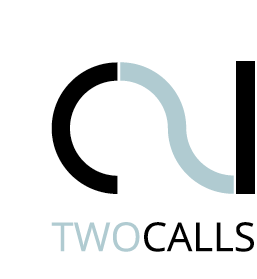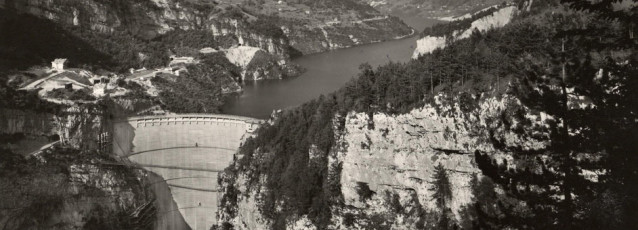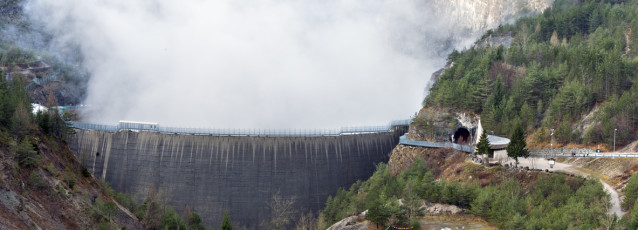The Two Calls for Vajont Contest was launched by Dolomiti Contemporanee last June.
Its intent was to propose a restoring cultural reflection for the Vajont area, to this day profoundly marked by the history of the tragedy.
Two artworks to be made through the Contest, one on the Vajont Dam (line), the other on the southern façade of the Spazio di Casso (wall), which faces the scar left by the landslide of Mt. Toc.
The first phase of the Contest, which involves the presentation of the projects by the artists, should have been about to be closed in a few days’ time, on October the 30th.
The organizers have, instead, decided to extend the deadline by another six months, taking it to April the 30th, 2015.
The creators of the Contest believe that it constitutes as an important occasion, to finally rethink the identity of this place, and its history, in a projective way.
The Contest, as we’ve said before, is an opportunity of cultural reflection, and an intellectual “construction site”, not a simple artistic award.
It is the proof that the human in this day and age knows and wants to face the meaning of this place, and its history, its present and its future, without closing itself up in a mute past.
During the first months, we’ve come to the understanding that activating such a reasoning, so full of responsibility, is a complex thing, for people, and for the artists themselves.
This Contest is demanding, and cannot be tackled without adequate effort: it posseses strong inertia.
We’ve want to share it with the largest number of people possible, giving it the visibility that it deserves, and giving the artists the time necessary to grasp it properly, developing thus their idea to the best possible degree.
These are thus the new temporal terms for Twocalls:
First phase (June the 12th 2014 – April the 30th 2015)
Submission of the projects through the methods described blow. The selected projects are going to be published on this website, in the line and wall sections.
Second phase (May the 1st – May the 20th 2015)
The jury will choose the two winning projects of the Contest, and will bestow the Special Dolomiti Contemporanee Awards.
Third phase (2016)
The two winning projects of the Contest will be realised.
–
il Concorso Two Calls for Vajont è stato avviato da Dolomiti Contemporanee nello scorso mese di giugno.
Esso ha inteso proporre una riflessione culturale rinnovativa per l’area del Vajont, ancora oggi profondamente segnata dalla storia della tragedia.
Due opere d’arte contemporanea, una sulla Diga del Vajont (line), l’altra sulla facciata meridionale dello Spazio di Casso (wall), che fronteggia il segno della frana del Monte Toc, verranno realizzate attraverso il Concorso.
La prima fase del Concorso, relativa alla presentazione dei progetti da parte degli artisti, avrebbe dovuto chiudersi tra pochi giorni, il 30 ottobre.
L’organizzazione ha invece deciso di prorogare tale termine di altri sei mesi, portandolo al 30 aprile 2015.
Gli ideatori del Concorso ritengono che esso costituisca un’occasione importante, per ripensare finalmente oggi l’identità di questo luogo, e della sua storia, in modo proiettivo.
Il Concorso, come abbiamo detto, è un’opportunità di riflessione culturale e un cantiere intellettuale, non un semplice premio artistico.
Esso è la dimostrazione che l’uomo sa e vuole fronteggiare oggi il senso di questo luogo, della sua storia, del suo presente e del suo futuro, senza chiudersi in un passato muto.
Nei primi mesi, abbiamo capito come attivare un simile ragionamento di responsabilità sia cosa complessa, per gli uomini, e per gli stessi artisti.
Questo Concorso è impegnativo, e non può essere affrontato senza un impegno adeguato: esso possiede un’inerzia elevata.
Vogliamo condividerlo con il maggior numero di persone possibile, dargli la visibilità che merita, concedere agli artisti il tempo necessario per metabolizzarlo adeguatamente, sviluppando al meglio le proprie idee.
Questi dunque i nuovi termini temporali per Twocalls:
Prima fase (12 giugno 2014 – 30 aprile 2015)
Invio dei progetto secondo le modalità indicate. I progetti selezionati verranno pubblicati su questo website, nella sezioni line e wall.
Seconda fase (1 maggio – 20 maggio 2015)
La giuria stabilirà i due progetti vincitori del Concorso e attribuirà i Premi Speciali Dolomiti Contemporanee.
Terza fase (2016)
I due progetti vincitori del Concorso verranno realizzati.

14/07/2015
On 18th July, at 5 pm at the Nuovo Spazio di Casso, the results of Twocalls will be presented to the public.
During the event there will also be the opening of twocalls, la forma delle idee (twocalls, the shape of ideas, in English), where a selection of the finalist projects will be exhibited.
19/05/2015
The Twocalls Contest entered its second phase. Lots of projects have been submitted in the latest days of the first phase, kept the Evaluation Committee busy longer than expected.
The Jury will nominate the winners in June.
Here a video, realized with the event Vajont 2015 – Progetti, held on 2 May in Casso, in which some members of the Jury, participants, inhabitants of the Vajont area, intertwine their opinions and ideas on the meaning of Twocalls regarding the history of Vajont and of its territory.
12/05/2015
On April the 30th the first phase of the International Artistic Contest Two Calls for Vajont, launched in June 2014 by Dolomiti Contemporanee drew to a close.
The Contest was conceived as an open platform of reflection on the territory of the Vajont and on its terrible history (October the 9th 1963), and as an opportunity to rethink, through the production of a series of renovating images, the landscape and some of the main symbols of that history today, transforming them from still objects-memories of the tragedy into active and shared “construction sites” of the mind and spirit.
















